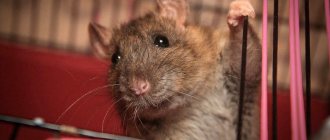What types of hamsters are there?
Rodents vary in color, size and coat type. There are five types of domestic hamsters in total. Their standards, The National Hamster Council, are set by the National Association of Hamster Fanciers of England.
Syrian hamster
This is the largest Syrian Hamsters from home. The average length of its body is 13 cm. Females are sometimes larger than males.
The classic color of the Syrian hamster is golden brown. There is black ticking on the back - this means that areas of different colors alternate on the hairs. The animal's belly is white with gray undercoat, and there are dark spots on its cheeks.
Individuals of other colors are often found: white, cream, brown, black, gold, silver-gray, striped.
Hamsters of this species can have different coats. There are four types in total:
- Short . The soft fur fits snugly to the body.
- Long . The length of the hairs is from 7.5 to 10 cm.
- Rex . The fur appears tousled.
- Satin . The hair has a glossy shine. It is not recommended to crossbreed two hamsters with such hair, because sometimes the offspring will be bald.
Syrian hamster with classic color. Photo: Olena Kurashova / Shutterstock
Campbell's Russian Hamster
The body length of such a rodent, Dwarf Exhibition Standards, is 10–12 cm. There are three main colors of the animal:
- Normal . The hairs on the back are brown. The belly is white with gray undercoat. The eyes are black.
- Argenta . The top layer of wool is orange-sand, the bottom is smoky-gray. The eyes are red.
- Albino . These are completely white pets with bright pink eyes.
Hamsters with gray, beige, black and chocolate fur are considered non-standard.
Campbell's Russian hamster with normal color. Photo: softkrafts.live.com/Depositphotos
Djungarian hamster
This Dwarf Exhibition Standards animal is sometimes called the Russian white dwarf hamster. Its body length is 8–10 cm. All pets of this species have a black stripe on their backs. There are only three colors:
- Normal . The body is dark brown, with black ticking on a third of the hairs. The paws and belly are white, and the ears are gray.
- Pearl . The rodent's fur is white.
- Sapphire . The fur on the back is smoky gray with a blue tint, the belly is white.
Sapphire colored Djungarian hamster. Photo: Faifarris4746/Shutterstock
Chinese hamster
This rodent looks like a mouse without a long tail. Its body length is 10–12 cm, weight is 45–50 g. There are two main colors of the Chinese Hamster animal:
- Normal . The back and sides are brown with a chestnut tint, the belly is white. A black stripe stretches from the forehead to the tail.
- Spotted . Most of the fur is white. There is an elongated brown spot along the spine.
Albinos with black eyes are extremely rare. They come in litters from spotted parents. But this is the exception rather than the rule.
Chinese hamster with normal color. Photo: alexvey/Shutterstock
Roborovsky's hamster
The smallest of domestic rodents. It weighs only 20–25 g, and its body length is 4.5–5 cm. Typically, these animals have golden-brown fur on their face and back. The roots of the hairs are gray, and there are light spots near the eyebrows. But very rarely there are hamsters with a white muzzle.
Roborovsky's hamster. Photo: Anyarnia/Shutterstock
Caring for a hamster at home
The basic rules for caring for a hamster are simple and easy to understand. There are few nuances that need to be studied by a person who dreams of purchasing this miniature pet for their home. They are associated with feeding the animal, bathing the animals, and their life rhythm, which depends on the time of year. Hobbyists who want to breed hamsters for sale are required to familiarize themselves with the most important information about the life of newborn babies of this species.
It is advisable to know for sure whether children and other family members are allergic to rodent fur. Review the layout of your living space to see if there is free and accessible space for a cage in the apartment. Talk to your children to see if your heirs are eager to look after the tiny tenant or are negative about this prospect.
What to feed hamsters at home?
Rodents in nature have learned to survive by eating both grain foods and animal products. They subconsciously avoid harmful plants or poisonous insects, avoiding poisoning. In apartments, pet owners are tempted to give their little ones pieces of food from the table in order to please the pet, which sometimes causes irreparable harm to them. When asking what you can feed hamsters at home, be careful; it is advisable to know exactly the foods prohibited for these animals.
Plant foods allowed for hamsters:
- ready-made dry diets for hamsters,
- sprouted grains of oats, wheat, other cereals,
- different types of nuts (hazelnuts, walnuts, peanuts),
- sunflower and pumpkin seeds,
- cherries, gooseberries, blueberries, other berries,
- pieces of vegetables processed in boiling water without salt,
- raw vegetables and fruits,
- peas in pods or grains,
- a small amount of rose hips and celery,
- Jerusalem artichoke fruits,
- dried fruits,
- branches of deciduous trees,
- greenery.
Allowed animal products:
- fermented milk products (cheese, cottage cheese, unsweetened yogurt) with a fat content of up to 1%,
- boiled chicken meat without spices,
- boiled eggs,
- boiled low-fat fish,
- in rare cases, pieces of peeled shrimp,
- worms and insects purchased from pet stores.
Domestic hamsters can easily tolerate care and maintenance at home, but for them there is an extensive list of prohibited foods:
- potato,
- fatty cheeses,
- ready-made bird feed,
- fresh bread,
- acorns,
- red beans,
- brazil nuts,
- any spices,
- fresh milk,
- garlic with onions,
- cabbage causes gas in hamsters,
- muesli,
- fried food,
- tropical fruits,
- honey,
- mushrooms,
- sweet cookies,
- wild-caught insects and bloodworms,
- tulip bulbs,
- chocolates,
- ice cream.
Hibernation of hamsters at home
The hibernation of these pets resembles numbness in appearance, which novice hobbyists often confuse with illness. With the beginning of winter, the life of hamsters at home goes into an economical mode; pets stop reacting to stimuli. The transition to hibernation is facilitated by several factors - a decrease in room temperature, a poor diet, and poor lighting. After being placed in a warm place, rodents will eventually awaken on their own, but it is not recommended to force them to wake up.
How to bathe hamsters at home?
It is recommended to arrange a shower or bath for pets in rare cases, as this procedure causes stress for them. It is advisable to treat animals with water after the appearance of parasites or in case of severe contamination of the fur. When asking how to wash a hamster at home, you need to use shampoos for rodents and moderately warm water, avoiding overheating the body. Carefully remove foam, dry your skin with a hairdryer or towels, hypothermia after a bath causes a cold.
Caring for newborn hamsters
The keeping of hamsters at home during this period changes slightly; the cage is not cleaned for two weeks after birth; the temperature is maintained at 21 °C. You cannot touch the offspring or disturb the nest after birth. The woman in labor is given a balanced protein diet rich in fats; babies begin drinking water at 10-20 days of age. When nursing babies on their own, they are pipetted with a hamster milk substitute or powdered infant formula; in the second week, babies begin to look for food without outside help.
What is the character of hamsters?
Rodents are active and curious Providing a Home for a Hamster. Animals are interesting to watch when they play in a cage. If a pet has been accustomed to communicating with a person since childhood, it can calmly sit in your arms. Hamsters rarely bite All About Syrian Hamsters: mainly when they are frightened by a sudden movement. Before communicating, for example, with Syriac, it is recommended to wash your hands. He has poor eyesight, so he relies on smell and touch. If the owner's fingers smell of food, the animal can taste them.
It is not worth keeping individuals in pairs. Even when they live together from an early age, conflicts can arise over time.
If you are still going to buy several animals, it is better to place them in different cages.
Keep in mind that rodents are nocturnal. They sleep during the day, so it is better to play with them in the evening. If you decide to wake up your All About Syrian Hamsters pet, do it very carefully. Talk to him in a gentle voice and lightly rustle the bedding in the cage.
What should be in a Djungarian hamster's cage?
Charming dzungariks attract attention even in the store. Of all the hamster breeds, they are the most popular and interesting. These curious and mobile creatures can constantly move around their territory, arrange it and stock up. You need to understand that for each type of rodent, it is necessary to create its own conditions for their comfortable existence. It’s great if the Djungarian hamster has a multi-tiered home. All kinds of stairs and passages, tunnels, grottoes and bridges will create not only a pleasant picture for the observer, but will also become excellent exercise equipment for the furry guest. What must be in a dwarf's cage is a running wheel. Physical exercise will help avoid obesity and strengthen your psyche.
When choosing accessories for your Djungarian hamster's cage, you can also prepare a chalk stone on which he will sharpen his teeth, and equip a sandbox with sand - this is where he will clean his fur coat.
It wouldn’t hurt to buy or make a labyrinth or tunnel with your own hands from scrap materials. It is important to remember that they must have ventilation holes, otherwise the rodent may have difficulty breathing over long areas.
Djungarian hamster cage
The sand in the sandbox must be changed at least once every 3 days, otherwise the hamsters will turn the bathtub into a toilet.
What living conditions does a hamster require?
It is best to house your hamster in a spacious wire cage, Choosing a Dwarf Hamster Cage. The minimum floor area is 60 × 30 cm. A plastic tray is considered a good option. But grated flooring is not suitable: your pet will easily injure its paws on it. The door of the home must close tightly. The distance between the rods is no more than 5 mm. Otherwise, the rodent may escape.
If you choose a multi-level design, pay attention to the height of the floors. The lower they are, the better. Then, when falling, the animal will not be seriously injured.
A pet store may offer you a plastic cage with pipes. Keep in mind: it will not provide adequate ventilation. In addition, it will be difficult to clean.
Hamsters are susceptible to cold and heat. They feel best at a temperature of 18–21 °C The ideal home for your hamster. Therefore, the cage is usually placed away from drafts, radiators and direct sunlight. If the room is too cold, the animal may hibernate. Loud sounds and vibrations cause stress in rodents. Therefore, it is worth finding a calm and quiet place for the house. There should be no TV or music system nearby.
Be sure to place a ceramic bowl inside the cage How to Care for Your Pet Hamster, and pour water into the nipple drinker.
A large layer of bedding should be laid on the pallet of the dwelling. Animals love to rummage in it. If you want to go with wood How to Care for Your Pet Hamster litter, choose aspen. Cedar and pine irritate the respiratory tract of hamsters.
The cage should also have shelter. The pet will rest there. If desired, you can buy a wooden or plastic house. Some owners use cardboard boxes. They wear out quickly, but are easy to replace.
Running wheel without cross supports. Photo: PetroP/Depositphotos
A hamster definitely needs a large running wheel. Try to find something that attaches to the cage. Typically, such models do not have transverse supports on which the animal can damage its paws. If you are a light sleeper, choose a quiet design.
To grind down the teeth that hamsters constantly grow, you will need wooden toys from Pet Hamster Toys. But some owners simply give their pets toilet paper or towel rolls instead.
Keeping hamsters at home
Hamsters are freely sold in pet stores, markets, and forums. There are no problems with houses for funny creatures; there are many options for how to independently equip a cage for a new pet. Under normal conditions, he will live next to his owners for several years, turning into a small member of the family. Before studying the question of how to keep a hamster at home, it is advisable to weigh all the advantages and disadvantages of bringing this original pet into your apartment.
Pros of raising hamsters in an apartment:
- These are extremely quiet animals, which do not disturb at all their screams or squeaks to their home inhabitants and neighbors.
- The hamster is a non-aggressive and unforgiving creature.
- If desired, rodents of any kind can be easily propagated at home.
- A cage or other device for an animal to live in does not take up much space.
- Hamsters are easy to care for and maintain at home; novice hobbyists will not have to study special, complex literature before purchasing pets.
- Children who look after furry creatures develop faster and become independent.
The main difficulties in the question of how to keep hamsters at home:
- To maintain cleanliness and eliminate sources of unpleasant odors, constant cleaning of the cells is necessary.
- Free-living rodents often damage furniture legs, wires, shoes, and other items. Hamsters require care and maintenance at home in cages or terrariums.
- Even timid pets can bite if treated incorrectly.
- Hamsters are capable of hibernating during the winter months.
Keeping a hamster at home in a cage
Glass jars or aquariums are suitable for animals as temporary shelter. If you decide to keep a hamster at home, then it is best to buy a comfortable and inexpensive cage for it. Experienced hobbyists recommend purchasing metal structures with horizontal bars and minimum dimensions of 50x30 cm. You cannot purchase cages with large lattice cells; tiny animals can easily escape into the gap between the wires. “Hamsters - care and maintenance at home” is a serious topic that requires a systematic approach.
How to set up a hamster cage:
- Rodents need two feeders for dry and wet food at the same time.
- Be sure to install a comfortable drinking bowl for your little pets.
- Hamsters require a mineral stone to regularly sharpen their sharp teeth.
- The animals are happy to use their activity on a durable and beautiful running wheel.
- Make entertainment equipment strong and safe, with a solid surface, to avoid unwanted injuries to pets.
- Sawdust, granular or pressed filler, helps get rid of odors.
House for a hamster at home
It is best to care for and breed hamsters at home in cages equipped with cozy houses. This device plays the role of decoration and a convenient shelter for timid pets. You can make it yourself or purchase it ready-made from retail chains; you can order a miniature apartment from hobbyists who make artificial housing for rodents from various materials.
Types of houses for hamsters:
- Outdated large ceramic dishes or new ceramic items are well suited as an original house; this material washes well and is difficult to spoil with teeth.
- Houses made from LEGO construction kits are easy to make even for a child; the bright buildings can be easily changed at will, making the fairytale castle unique.
- Many craftsmen build miniature huts or mansions from scraps of wood.
- Corner or square buildings can be made from plywood; for this purpose you need a little sheet material and the simplest tools.
- Real ready-made universal amusement parks for hamsters are available in a wide range in pet stores.
- Any strong and easy-to-process material, such as coconut, is suitable for making a house.
- Hamsters are cheerful and cheerful animals; care and maintenance at home is rarely complete without active games and fun. Even from simple cardboard or paper boxes, your children can build not just a house, but a large walking labyrinth.
What to feed a hamster
The majority of the diet should be prepared food What Can Hamsters Eat? , for example crumbly mixtures. They contain grains, seeds and dried vegetables. The disadvantage is that hamsters pick out the tasty morsels. Less tasty but healthy additives often remain in the bowl. Therefore, you need to make sure that the animal finishes everything. If you have no time to control your diet, it is better to choose granulated food.
Hamsters can also be given human food, but its amount should not exceed 10% of the diet. Here are examples of safe products:
- Vegetables : broccoli, carrots, cauliflower, cucumber, potatoes (cooked), spinach, cabbage.
- Berries : grapes, blueberries, strawberries.
- Legumes : young beans and peas, dry or steamed lentils, unsalted peanuts.
- Fruits : apples (without seeds), bananas.
Animals are also sometimes given hay, dandelion leaves, crickets and mealworms.
You cannot feed your hamster citrus fruits, raw potatoes, apple seeds, dry peas, onions, garlic, almonds, sweet and salty foods.
Lifestyle
Hamsters are quite active and mobile, and also very curious, which is why it is best to keep them in a cage. But the home should be quite spacious, since these animals move a lot and move around often. These rodents are solitary by nature, so it is not worth purchasing two individuals at once, because if they do not get along, then fights and injuries cannot be avoided.
In the wild, hamsters dig complex burrows, so at home they need to be provided, firstly, with a secluded corner, and secondly, with the opportunity to dig. These rodents do not hibernate, especially domesticated ones.
How to care for a hamster
To keep your pet healthy, you need to regularly clean its cage. Do this in the evening The ideal home for your hamster, when the animal is awake. Dispose of How to Clean a Hamster Cage stale food scraps from bowls every day. Pour clean water into the drinking bowl. Remove feces and wet areas of litter.
If your home looks clean, but it smells bad, you need to replace the filler completely. Sometimes rodents bury food in it, which eventually begins to rot.
Do general cleaning once a week. All you need is a sponge and a non-toxic disinfectant from a pet store. The latter can be replaced with mild hand soap: aggressive chemicals are poison for your pet. When everything is ready, remove the hamster from the cage and place it in a safe place. Don't forget to keep an eye on him. Thoroughly rinse the structure, bowls, running wheel and other accessories. Make sure everything is dry before putting it back in place.
How to set up a hamster cage
If we consider ready-made options, they contain the necessary, but not always high-quality accessories for a hamster cage:
- house;
- running wheel;
- stairs;
- drinking bowl;
- feeder
Bedding and toys are sold separately. Our recommendations will help you properly set up your cage.
House
Rodents use the house to hide from prying eyes, here they can store supplies and make a cozy nest. By nature, most hamsters are large sleepyheads, so they spend most of their short lives in it. Ready-made cages are usually supplied with small plastic houses - minks, which are suitable for keeping small breeds or young animals.
It is worth preparing nesting material in one of the corners of the cage; it can be ordinary pieces of paper napkins, soft paper, or special material from a pet store. It will be interesting to watch your pet when he happily begins to arrange his home in accordance with his own preferences. You should not offer your hamster wool or cotton wool as nesting material. They split into separate threads, and the animal can become entangled in them or eat them.
running wheel
We must remember that hamsters like to use their exercise equipment exactly when you turn off the lights and go to bed. That is why you should make sure that the running wheel rotates completely silently and does not disturb your peace.
You should not use wheels with mesh steps. Your fur baby's paw may fall through and get stuck.
Drinking bowl
A drinking bowl is always more hygienic and practical than an ordinary saucer. It is attached to the cage wall from the outside, does not take up space and does not turn over. Don’t be afraid that your pet doesn’t know how to use a water bottle; rodents find a use for it very quickly on their own.
A classic bottle sippy cup with a metal tube and a plastic ball at the end works great, so you can buy one and use it.
Feeder
A ceramic bowl is suitable as a feeder; it is more stable than a plastic one, and a hamster climbing inside will not be able to turn it over. The plastic hamster feeder, which usually comes with the cage, is not practical and easily tips over.
Toys
Toys are necessary for grinding teeth; they can be purchased or made from scrap materials. Hamsters love to play with cardboard toilet paper rolls and chew cardboard. It is necessary to ensure that such toys do not have drawings or inscriptions - paint is harmful to the digestive system of a rodent.
You can make a ladder out of popsicle sticks using non-toxic glue. It should be remembered that furry pets taste all new toys.
Hamster toilet
Special toilet corners are available for sale. They are made of plastic, can be of different shapes and most often have special attachments to the corner of the cage. In the absence of a special device, for the first time you can use an ordinary metal can lid or a plastic tray with low sides for food as a toilet. For the toilet, it is preferable to use corn litter, which absorbs and retains odor well. You can use pressed sawdust for these purposes with great caution - some hamsters may develop an allergy to them.
It is strictly forbidden to use pine or cedar sawdust as filler.
What does a hamster need to put on the bottom of its cage?
It is most convenient to use wood shavings as bedding. She needs to be placed in a cage for two reasons:
- pet feces have an odor, so it is better to place a safe and well-absorbing filler at the bottom;
- hamsters love to make their nest out of it.
What do hamsters get sick with?
Hamsters are fragile animals. Any injury or illness can seriously affect your health. You need to know about potential problems at Hamster Health and Diseases in order to take your animal to the veterinarian in time.
Abscesses
These are bumps filled with pus. They form under the skin and mucous membranes and can even appear due to minor cuts or scratches. If your hamster constantly looks like he's got food in his mouth, take him to the vet. There may be an abscess in the cheek pouch. The doctor will remove it and prescribe antibiotics.
Respiratory infections
You can suspect them if the animal sneezes frequently and fluid leaks from the nose and eyes. Problems are also indicated by wheezing, difficulty breathing, loss of appetite and laziness.
Enteritis
Some call this deviation "wet tail." Symptoms include diarrhea, loss of appetite, ruffled fur and lethargy (decreased activity, prolonged sleep). The disease is deadly. It most often occurs in hamsters that have recently been weaned from their mother.
Skin diseases
These are ringworm, fur mites, fungal and skin infections, allergic dermatitis. Take your pet to the vet if he itches frequently. The disorder can also be determined by peeling and redness on the skin.
What kind of animal is that?
The hamster is a small and tightly built rodent with short limbs, short, almost invisible tails and small ears. The color of the animal depends on the specific species and can be almost anything: from light beige to gray, brown and even black.
And some individuals have an interesting and unusual color. The body length of such an animal can vary from 5 to 25-30 centimeters (in some species, females are larger than males). All hamsters have very developed cheek pouches, in which they hide food supplies.
By the way, in the wild, some individuals make reserves, the total mass of which can be 70-90 kilograms. Hamsters most often live in steppes, mountainous regions, and also in deserts. The lifespan of this animal is on average 2-3 years.
There are about 20 species of hamsters in total, but the most commonly kept at home are Syrian, Roborovsky and Djungarian hamsters, as well as Campbell's hamsters.
What to look for when buying a hamster
You can buy an animal at a pet store or from a breeder. Choose a cat that is about 6 weeks old How To Choose a Healthy Hamster.
The cage where the animals are kept must be clean and spacious and provide free access to food and water for all animals.
Examine your favorite rodent. Normally, he is not too fat or thin, and his stomach is not bloated. The coat is fluffy and smooth, there are no bare areas on the body. Tangled hairs on your chin are a bad sign. When everything is fine, the anus, eyes, nose and ears are dry. No liquid leaks from them. If possible, check your teeth too. In healthy animals they are even and moderately long. Listen to your hamster's breathing. Wheezing, clicking or gurgling sounds should alert you. Place your pet on the table and make sure it moves well and is not limping.
If one of the cage neighbors seems unhealthy, it is better to refuse the purchase and look for another store or breeder.
What else should you consider when keeping a hamster in your home?
To keep your hamster calm and not experience stressful situations, remember the following:
- house him separately from other hamsters;
- provide the hamster with peace and quiet;
- You should not show your hamster other pets;
- clean your hamster's house when he doesn't see it;
- do not interfere with his lifestyle;
- never punish hamsters;
- do not take it outside or let it on the grass; direct sunlight is especially dangerous for it; it can die in just a few minutes.
If you plan to not only keep, but also breed hamsters at home, then this will not be too difficult. They are capable of producing regular offspring and independently feed up to ten broods throughout the year. To do this, the mother hamster needs to create appropriate conditions - ensure peace and not be taken out of the cage during pregnancy.
As you can see, keeping pet hamsters in an apartment is not so difficult. If all necessary conditions of maintenance and care are observed, this animal will delight you and especially your children for a long time, who will play with hamsters with great pleasure.
Features of care
How to care for a pet hamster? The most important points:
- You should not take your pet outside; he may catch a cold or get scared and run away. Just set up an entertainment area right at home.
- How to bathe a hamster? In general, these rodents clean their fur on their own, so just place a container of sand in the cage (purchase sand at the store). If your pet is very dirty, wash it in warm water using a special shampoo. Soap is unacceptable, it will dry out the skin. Hold your hamster firmly during the procedure. Be careful not to get water into your eyes or ears. After bathing, wrap your pet in a soft towel.
- Monitor the animal’s condition; if it worsens, immediately go to the veterinarian, as all diseases of these rodents progress rapidly.











